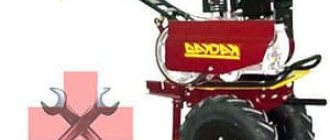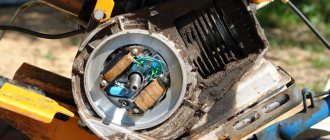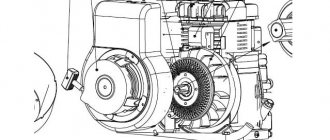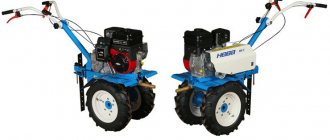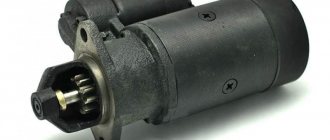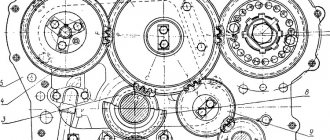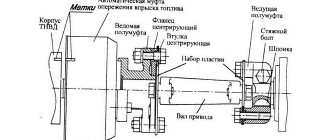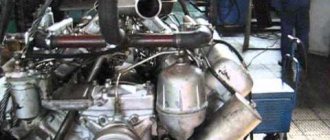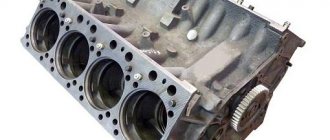The start of any internal combustion engine is directly related to the ignition system. If it fails, the motor will not work. In order not to seek help from specialists and in order to save money, the owner of a walk-behind tractor must learn to set the ignition on his own. It is this that ensures timely ignition of the combustible mixture in the cylinder. This occurs at the moment of maximum compression of the piston, when the compression reaches its greatest density. At this time, the magneto supplies a spark through the spark plug into the combustion chamber, and the mixture ignites.
Techniques - searching for words by mask and definition, answers to scanwords
google.com/x technology. walk-behind tractor [edit] [upload image] [top] …. works on history, medicine, botany, agricultural and construction technology..... (French fumage - smoking) a technique that uses traces of soot from a candle on...
If you suddenly need to replace a spark plug, then this section of the online store will be useful, since we offer the widest selection of different spark plugs for mopeds, scooters, motorcycles, ATVs, snowmobiles, spark plugs for walk-behind tractors, chainsaws, even for imported boat engines, and this far from the limit!
Magneto for walk-behind tractor - testing at home
The magneto on a walk-behind tractor is a structurally complex element that is in constant contact with high-voltage wiring and interacts with electricity. Due to operation of the walk-behind tractor in wet weather, accidental impacts and failures in the electrical power supply, this part gradually fails.
To check the magneto of a walk-behind tractor, you will need:
- Carefully remove the cap from the candle screwed into its standard place and insert a small nail in its place. The latter must be clean, without signs of corrosion;
- The nail must be installed at a distance of 7 mm from the cylinder wall of the standard cylinder of the power unit of the walk-behind tractor;
- Start the engine of the agricultural unit;
- Check if a spark appears when starting the engine. It should be painted bright blue and clearly visible. If this is not the case, then the magneto has failed.
If the magneto breaks, it will need to be replaced. You can do this yourself by removing the faulty part and installing a new part.
Experience of owners of operating the Neva MB-2 walk-behind tractor - reviews from forums
Each farmer's experience is unique. The advice of those who use the same walk-behind tractor as you do on their plot of land is especially valuable. Next - some advice from owners of the Neva MB-2 walk-behind tractor regarding maintenance and troubleshooting.
Vitaly, Penza, Russia:
“I bought a Neva mb2 walk-behind tractor and was very pleased. The unit worked normally at first, but a week after the start of operation, white smoke began to emerge from the exhaust pipe. I tried to slow down the engine speed, but it didn't help. It turned out there was water in the float chamber. I drained the gasoline, let it settle, and drained the chamber. After that the walk-behind tractor worked perfectly. If anyone has had a similar problem, I advise you to use my experience!”
Alexey, Rostov-on-Don, Russia:
“I encountered the following problem: in first gear my walk-behind tractor cultivated normally, but when I switched to second gear and worked with the soil, the engine speed did not drop. When I went deeper into the ground, the cutters stopped. Knowledgeable people suggested that the problem might be in towing the belt. I adjusted the tensioner and shortened the chain on the clutch handle and the problem was solved! Now I work with pleasure, I’ve been using my Neva MB2 for two years now.”
Konstantin, Rivne, Ukraine:
“I’m not new to working with a walk-behind tractor; I’ve been using it for 4 years. Recently, if you put a load on it, the engine began to stall, as if it couldn’t pull... I barely drove it into the garage, and there was no popping noise, no smoke. The cause of the malfunction was simple: the air filter was clogged. I had to replace it and now the car runs like a beast.”
You can also help other readers of our site with your reviews on this walk-behind tractor model and its maintenance and main faults.
If you are the owner of this walk-behind tractor model, you can leave a review about its maintenance and operation, or ask any question you are interested in regarding the breakdown or maintenance of this model below in the comments.
Today, more and more people use walk-behind tractors on their plots. This is not surprising, because such equipment can do absolutely everything: plow the ground, plant and harvest potatoes, transport cargo, and even remove snow. However, like any other machines, walk-behind tractors sometimes break down and require repair.
In this article we will look at the ignition system of a walk-behind tractor, the types of its breakdowns, how to eliminate them, as well as the process of adjusting the ignition. And if the cause of the malfunction lies precisely here, it will not be difficult for you to eliminate it.
Preventive measures
As preventive measures, a number of rules are used that should be followed for the system to operate fully and efficiently. Prevention:
- excluding the operation of equipment in high air humidity, for example, in fog or rain. It is worth excluding use during temperature changes;
- do not use the equipment if there are any foreign odors from the engine or other systems, as well as if there are any detected problems;
- it is necessary to use protective plates that prevent moisture from entering the ignition system mechanisms;
- The spark plug is replaced at least once every three months or more often. Especially if operation occurs under conditions of increased loads;
- the oil must be of high quality, otherwise the composition will not be suitable for the walk-behind tractor and the spark plug will flood;
- regular inspection of systems for breakdowns or exposed wires;
- During intensive work, the unit cannot be kept under constant loads. It is necessary to give it rest, including for a little cooling of the engine.
How to check the performance of a spark plug?
- We turn out the candle.
- Wipe the electrodes well.
- If there is carbon deposits on the spark plugs, it needs to be cleaned.
- We set the gap between the electrodes.
- We put a high-voltage wire square on the spark plug.
- We press the spark plug body to the cylinder head.v
- When performing the previous point, you should pay attention that the electrodes are facing away from the hole for the spark plug.
- We turn the crankshaft and see if a spark appears. If there is a powerful and bright spark, then the adjustment has been made correctly.
An important role in the operation of the ignition is played by the gap between the stater and the magnetic shoe of the flywheel. It should be no more and no less than 0.1 - 0.15 mm. What to do if you need to adjust the gap:
- Remove the housing from the fan.
- Loosen the stator mounting bolts.
- We insert the dipstick plate, set the gap and screw in the bolts.
- Check the clearance around the entire circumference of the flywheel.
Such simple instructions will help you restore the ignition and easily identify the cause of its malfunction with your own hands. If you are confident in your technical knowledge, then performing these steps will not be difficult. In order to avoid breakdowns of the walk-behind tractor in the future, you should carry out regular diagnostics, which will allow you to immediately identify all sorts of problems and correct them in the first steps.
Which engine is better to put on the Cascade walk-behind tractor?
It is necessary to take into account the fact that the domestically produced engines that were produced for this walk-behind tractor no longer exist. So you will need to choose among the imported assortment. But it’s almost impossible to find a part that meets all the parameters. Most often, you still need to purchase an additional set of fasteners (belt, stabilizers, pulley, platform), since many engine models may differ in different seats or shaft diameter.
The following engines are most often installed on the Cascade:
- DM 68 is a good quality engine, which is recommended as one of the best options for installation on such equipment. Its main advantage is a reinforced transmission and high-quality assembly. Technical characteristics: power - 6 hp;
- fuel tank: 3.3 l;
- processing depth – 26 cm;
- processing width – 45/60/95 cm;
- number of gears: 2 forward, 2 reverse.
- reinforced transmission;
When purchasing an engine, pay attention to its build quality. It must meet all modern requirements, this will ensure the unit a long service life and operational efficiency
Breakdowns and ways to fix them
There are quite a lot of malfunctions in the ignition system. For this reason, parts of the ignition system must be checked and adjusted regularly.
The main problem is the lack of spark. When ignited, a spark should form. If this does not happen, then the entire ignition system needs to be checked. The absence of a spark is possible due to carbon deposits, as well as when the spark plug breaks. These faults are the most common.
If there is no spark, the spark plug is unscrewed and inspected. The side and central electrodes must be free of carbon deposits. If there is carbon deposits, it is worth not only cleaning, but also checking the fuel system for pipe leaks. The carbon deposits are cleaned thoroughly. After the procedure, the candle must be wiped with a dry cloth.
Don't forget about checking the magneto
Standard procedure for no spark:
- remove (unscrew) the spark plug;
- the candle is heated over a gas burner or other heat source;
- carbon deposits and fuel residues are scraped off the surface;
- the tip is put on and the spark is checked, that is, the electrode is located 1 mm from the engine body. The motor itself is started by hand at this time;
- if the spark plug is working, a spark will appear; if this does not happen, then the distance between the side and central zones of the electrodes is measured;
- if the blade fits tightly into the gap, then everything is within normal limits; if not, then you need to hit the back of the central part of the electrode. This will help resize;
- Next comes a secondary spark test.
Important! Immediately after checking the spark plug, the magneto is checked.
You can check the magneto in a step-by-step manner:
- the spark plug is cleaned and checked for serviceability;
- a small special cap is put on the end of the spark plug to ensure that the drive is working properly;
- the lower part of the spark plug is brought to the body of the magneto;
- the flywheel rotates manually;
- if there is no spark, then the magneto will need to be replaced with a working mechanism.
Replacement is mandatory, as this will prevent wear and tear on the remaining engine mechanisms.
The coil is checked using a standard system, which is also used for magnetos.
There are several signs of a bad coil:
- lack of spark or its actual weakness;
- a smell similar to melted plastic at the location of the coil;
- cracking sound when trying to start the equipment.
Any repair begins with a careful inspection. The initial step is to dismantle the mechanism. To do this, the mounting bolts are unscrewed and the top case-type cover is removed. The high voltage wire is disconnected. Only after this the coil itself is pulled out. The first inspection should reveal areas of melting (black spots). Most often, this disadvantage occurs with contactless ignition.
A common reason for the lack of current supply to the spark plug is poor contact. The fix is regulated by stripping the wires. In some cases, it is necessary to completely replace all wires.
Important! If the equipment uses automatic (electronic) ignition, the wire turns off independently using a special type of fuse.
With standard starting systems, including manual ones, you must disconnect the wires yourself.
Basic faults
Belt adjustment and dimensions
For the Neva MB-2 walk-behind tractor, the A-1180 drive belt is used. This model uses one belt that provides forward movement.
In other modifications of the Neva MB-2 model, two drive belts are used. Reverse gearing occurs in the gearbox itself.
Replacing the belt for MB-2 walk-behind tractors is carried out in the following sequence:
- The shield is removed, and then the pulley protective cover.
- The spring from the walk-behind tractor rod is removed to loosen the belt.
- The screws securing the bracket are turned.
- The bracket rotates to a position in which the limiting pins do not prevent the part from being removed from the pulley.
- The pulleys are adjusted, and then a new belt is installed.
- Pull the belt onto the gear shaft pulley, and then onto the motor pulley.
- In reverse order, place the remaining parts in their places.
Replacement of gearbox seals
The oil seals in the Neva MB-2 walk-behind tractor are replaced if an oil leak is detected. This condition is dangerous because the walk-behind tractor gearbox may be left without oil, and this will lead to rapid wear of the unit.
The sequence for replacing oil seals is as follows:
- Remove the cutters from the shaft, cleaning the shaft and covers from dirt and oil residues.
- Unscrew the cover bolts, tap off the oil and debris, and remove the cover from the gearbox.
- The old oil seal is replaced with a new one and wiped dry.
- The cover is returned to its place (if necessary, it is placed on sealant) and fixed with bolts.
Adjusting and tuning the Neva MB-2 carburetor
The functionality and durability of the walk-behind tractor engine depends on the stable operation of the carburetor. This is why its adjustment and tuning are so important. In addition, if the carburetor is incorrectly configured, a gasoline walk-behind tractor may experience increased fuel consumption
The carburetor of the Neva MB-2 walk-behind tractor is adjusted as follows:
- The full throttle and idle screw are turned to the limit.
- Both screws are unscrewed 1-1.5 turns.
- Next comes starting and warming up the engine.
- The throttle control lever is placed in a position in which the engine will operate at minimum speed.
- Set the minimum idle speed until the unit operates stable.
- The idle speed is set to maximum.
- The minimum idle speed is adjusted.
- Steps 6 and 7 are performed until the engine runs smoothly (more smoothly by ear) at idle speed.
For long-term and uninterrupted operation of the walk-behind tractor, it is necessary to regularly perform engine diagnostics, monitor the frequency of oil changes, and also comply with operating conditions and time intervals for scheduled maintenance.
Adjustment of valves
Adjusting the valves is a fairly simple procedure that requires wrenches, screwdrivers and a feeler gauge. The valve adjustment process is needed to establish optimal and technically correct clearances between the valves of a walk-behind tractor engine. Adjusting valves using the example of the Neva MB-23 walk-behind tractor (the principle is the same for everyone)
MB 1
MB 1 is the predecessor of the Neva and the same type of ignition option.
Important! Spark plug failure is the most common failure, so it is necessary to have a spare spark plug that has been tested.
All settings and adjustments of the ignition of the walk-behind tractor are carried out only on proven spark plugs that have already been in use.
For engines of type DM 1 or modifications, the list of the most suitable spark plugs includes:
- a11-1;
- a11-0;
- a17B;
- si12rt.
All these options have a thread size of 1.2 centimeters.
It is worth considering that profile candles from various well-known brands are well suited. For example, B8AC.
Saving on candles in the presence of MB class equipment is unacceptable. The same applies to modifications like NEVA.
Checking the performance of the spark plug:
- the candle is turned out;
- wiping the electrodes with a dry cloth;
- removing carbon deposits if present;
- the gap is established between the electrodes;
- a square from a high-voltage wire is attached to the spark plug;
- the spark plug body is pressed against the head of the cylinder;
- Then the crankshaft is turned and it looks to see if there is a spark.
In this way you can check any type of candle.
Important! The clearance size between the starter system and the magnetic shoe is from 0.1 to 0.15 mm.
If the gap is of a different size, it will need to be adjusted. It is worth remembering that each type of walk-behind tractor has its own gap size, but for MB modifications it is located in the range of 0.1-0.15.
Don't forget about the gap
Neva-type equipment differs from similar walk-behind tractors in increased wear resistance and efficiency, but it is necessary to check the ignition coil on the walk-behind tractor before starting work.
The ignition coil is adjusted in the standard way:
- A landscape sheet of A4 format is folded into four;
- two bolts on the module mounting are loosened;
- a folded sheet is placed under the pillow;
- the pillow is pressed through, the fastening bolts are tightened;
- the flywheel rotates;
- check for spark;
- the mechanism is fully installed.
If the cultivator undergoes a major overhaul or any replacement of parts, then the ignition of the MB walk-behind tractor is also checked.
According to clearance checks for MB and further modifications, including the new Neva model range, there are differences in the size of the required clearance. Most of it is set in the operating instructions, which are individual for different types of models.
What to do if there is no spark on the walk-behind tractor?
If after the tests it turns out that the spark has disappeared, then the cause of this breakdown must be sought in the main elements of the ignition system of the agricultural unit.
To do this you will need:
inspect the spark plug - it needs to be unscrewed using a special key; the spark plug may be completely dry - this indicates that fuel is not entering the engine cylinder, that is, the fuel pipes are clogged or the carburetor is malfunctioning; in some cases, the part turns out to be wet from gasoline and motor oil. The reasons for this are an excess of lubricant contained in the fuel, or its leakage from the engine oil sump directly into the cylinder. In this case, the operator must remove the spark plug and dry it thoroughly. After this, you need to dry the cylinder, intensively pull the starter cable several times on the engine with the spark plug turned out; Most often, due to the lack of proper and timely maintenance of agricultural machinery, a thick continuous layer of soot and dried resinous deposits forms on the spark plug of a walk-behind tractor.
To restore the candle, you need to carefully heat it with a lighter and wash off the remaining resin with clean gasoline. After this, the part will need to be dried and screwed into place.
If this does not help, then the spark plug needs to be replaced.
It is important to proceed with extreme caution when removing, cleaning and reinstalling the spark plug.
Any careless movement can damage the electrodes of the part, causing it to no longer generate a spark.
Description
Motoblocks "Cascade" have proven themselves as reliable farmer's assistants. These are productive, durable machines capable of working with a full range of mounted implements, performing the functions of a cultivator, plowing machine, mower, snow blower and many others.
Timely maintenance of the walk-behind tractor is also important. For the Cascade, the maintenance schedule is the same as for any other household walk-behind tractor:
- scheduled maintenance: once a season, at the end of seasonal work and before it begins (at the beginning and end of spring, at the beginning and end of summer, etc.);
- regular mini-inspection - every day upon completion of work and turning off the walk-behind tractor, as well as an external inspection in order to identify damage, chipped paint, etc.;
- winter storage - is allocated to a separate maintenance category, since it involves draining all fuels and lubricants and storing the walk-behind tractor in a room with a positive temperature; upon completion of the winter “preservation” the unit is refilled with fuel and lubricants;
- annual engine prevention (detecting faults, eliminating them, maximizing the service life of the motor and other key components of the unit).
Next, we will look at the basic rules and requirements for fuels and lubricants, the process of starting and running in the Cascade walk-behind tractor, as well as the most common malfunctions of these devices.
Main technical parameters
Heat number. This parameter means the spark plug’s ability to guarantee complete ignition of the fuel mixture inside the Lifan engine cylinder. If the spark plug is not able to heat up to the required temperature, the fuel does not burn completely. Otherwise, there is a possibility of glow ignition of the mixture at absolutely any time.
There are 4 different types of candles based on their heat rating:
- hot (11-14) - for internal combustion engines with low afterburner:
- cold (20) - for highly accelerated and powerful engines;
- medium (17-19) - more universal options;
- unified (11-20) - have a semi-open structure that prevents the candles from clogging.
Spark gap. There is a gap between the electrodes of the spark plug, where the spark occurs. It varies depending on the manufacturer and the technology used, as well as the materials used. It is necessary to select spark plugs according to the make of the car or internal combustion engine for your equipment.
Dimensions. In each Lifan engine, the spark plug hole may be slightly different. To buy the spark plugs that are right for you, you should know this value. The dimensions of the candle you need depend on this parameter. All sizes are typical, standard and always available in any modern auto parts store.
Material. This factor also cannot be overlooked. A candle is made not from one material, but from several. This is related to its purpose, as well as the characteristic features of the structure. The side electrode is in most cases made of alloy steel.
But the central electrode is made of pure nickel or its alloy with copper. The tip is made of alloys to which rare earth metals are added. Among them, iridium, tungsten, and platinum should be highlighted. This method makes it possible to extend the service life and, in addition, increase resistance to soot.
